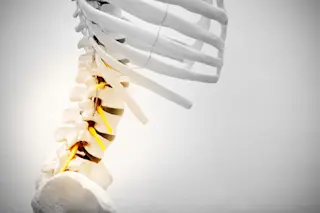1. Thanks to evolution, your back is a marvel of load-bearing support and flexibility — and kind of a mess. Our species is prone to back pain, for example, because our ancestors’ imperfect transition to upright walking essentially took a spine similar to that of our nearest living relatives, knuckle-walking chimpanzees, and forced it vertical with piecemeal adaptations.
2. A 2015 study found that some people are, well, chimpier than others. Humans prone to certain back problems have vertebrae closer in shape to those of a chimpanzee than those of pain-free humans.
3. Regardless of shape, you might have more (or fewer) of the bones than your neighbor. Not everyone has the standard 33 vertebrae: From top to tail, that’s seven cervical, 12 thoracic, five lumbar, five sacral and four coccygeal.
4. The number of vertebrae in individual Homo sapiens actually varies between 32 and 35, with the biggest range ...















